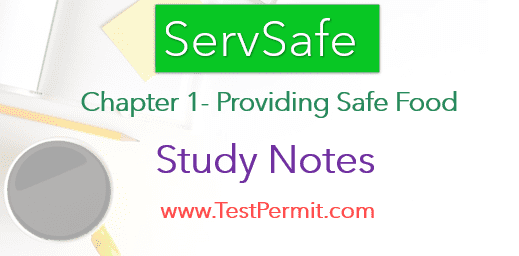ServSafe Chapter 1- Providing Safe Food Notes & Study Guide for Food Handler, ServSafe Manager, Alcohol, and Allergens exam preparation.
ServSafe Chapter 1- Notes & Study Guide
Guided Notes – Chapter 1 Providing Safe Food
Challenges to Food Safety:
A foodborne illness is a disease transmitted to people through food
An illness is considered an outbreak when:
- Two or more people have the same symptoms after eating the same food.
- An investigation is conducted by state and local regulatory authorities
- The outbreak is confirmed by laboratory analysis
Challenges include:
- Time and money – Pressure to work quickly can make it hard to take the time to follow food safety practices.
- Language and culture – Your staff may speak a different language than you do, which can make it difficult to communicate. Cultural differences can also influence how food handlers view food safety.
- Literacy and education – Staff often have different levels of education, making it more challenging to teach them food safety.
- Pathogens – Illness-causing microorganisms are more frequently found on food that once was considered safe.
- Unapproved suppliers – Food that is received from suppliers that are not practicing food safety can cause a foodborne-illness outbreak.
- High-risk customers – The number of customers at high risk for getting a foodborne illness is increasing. An example of this is the growing elderly population.
- Staff turnover – Training new staff leaves less time for food safety training. The ServSafe program will provide the tools needed to overcome the challenges in managing a good food safety program.
How Food Becomes Unsafe:
Five risk factors for foodborne illness:
-
- Purchasing food from unsafe sources
- Failing to cook food correctly
- Holding food at incorrect temperatures
- Using contaminated equipment
- Practicing poor personal hygiene
- If food is not handled correctly, it can become unsafe. These are the five most common food-handling mistakes, or risk factors, that can cause foodborne illness.
- Except for purchasing food from unsafe sources, each risk factor for foodborne illness is related to four main factors: time-temperature abuse, cross-contamination, poor personal hygiene, and poor cleaning and sanitizing.
Poor cleaning and sanitizing:
- Equipment and utensils are not washed, rinsed, and sanitized between uses
- Food-contact surfaces are wiped clean instead of being washed, rinsed, and sanitized
- Wiping cloths are not stored in a sanitizer solution between uses
- Sanitizer solution was not prepared correctly
Food Most Likely to Become Unsafe:
The list of TCS (temperature control for safety) food includes the following:
- Milk and dairy products
- Shell eggs except those treated to eliminate Salmonella )
- Meat: beef, pork, and lamb
- Poultry: chicken, turkey, duck
- Fish
- Shellfish and crustaceans – shrimp, lobster, crabs, crab legs
- Baked potatoes
- Heat-treated plant food, such as cooked rice, beans, and vegetables
- Tofu or other soy protein; synthetic ingredients, such as textured soy protein in meat alternatives
- Sprouts and sprout seeds
- Sliced melons; cut tomatoes; cut leafy greens
- Untreated garlic-and-oil mixtures
Ready to Eat Food (RTE)
Ready-to-eat food is food that can be eaten without further:
- Preparation
- Washing
- Cooking
Ready-to-eat food includes:
- Cooked food
- Washed fruit and vegetables
- Deli meat
- Bakery items
- Sugar, spices, and seasonings
Like TCS food, ready-to-eat food also needs careful handling to prevent contamination.
Populations at High Risk for Foodborne Illnesses
These people have a higher risk of getting a foodborne illness:
- Elderly people – Elderly people are at high risk because their immune systems have weakened with age.
- Preschool-age children – Very young children are at high risk because they have not yet built up strong immune systems.
- People with weakened immune systems – People with compromised immune systems include:
- People with cancer or on chemotherapy
- People with HIV/AIDS
- Transplant recipients
- People taking certain medications
Keep Food Safe
- Controlling time and temperature
- Preventing cross-contamination
- Practicing personal hygiene
- Purchasing from approved, reputable suppliers
- Cleaning and Sanitizing
Set up standard operating procedures that focus on these areas. The ServSafe program will show you how to design these procedures.
Training and monitoring:
- Train staff to follow food safety procedures
- Provide initial and ongoing training
- Provide all staff with general food safety knowledge
- Provide job specific food safety training
- Retrain staff regularly
- Monitor staff to make sure they are following procedures
- Document training
Managers must set up standard operating procedures (SOP’s) that focus on these measures. Then they must train their staff on these procedures and monitor them to make sure the procedures are followed.
Keeping Food Safe:
Government agencies:
- The Food and Drug Administration (FDA) – The Food and Drug Administration (FDA) inspects all food except meat, poultry, and eggs. The agency also regulates food transported across state lines. In addition, the agency issues the FDA Food Code, which provides recommendations for food safety regulations.
- S. Department of Agriculture (USDA) – The U.S. Department of Agriculture (USDA) regulates and inspects meat, poultry, and eggs. It also regulates food that crosses state boundaries or involves more than one state.
- Centers for Disease Control and Prevention (CDC)
- S. Public Health Service (PHS) Agencies such as the Centers for Disease Control and Prevention (CDC) and the U. S. Public Health Service (PHS) conduct research into the causes of foodborne illness outbreaks.
- State and local regulatory authorities – State and local regulatory authorities write or adopt the food code that regulates retail and foodservice operations.
